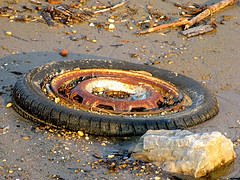5 Warning Signs That You’re Buying A Flood-Damaged Car Image courtesy of (frankieleon)
You’ll probably want to start with a vehicle history report, as that should show you any major repairs made to the car. Unfortunately, clever, underhanded sellers know how to hide these details, meaning you should check for a handful of physical indicators that the car you’re checking out might have once been underwater:
The following tips from this Edmunds.com article [via CTwatchdog.com] published in the wake of 2011’s Hurricane Irene are still just as valid following Sandy’s cross-country trip:
1. Be alert to unusual odors.
Musty or moldy odors inside the car could indicate that the seller wasn’t able to completely clean out flood-related mildew. Conversely, be wary of strong air freshener or cleanser scents, as they may be trying to mask the stinky culprit. “Run the air-conditioner to see if a moldy smell comes from the vents,” adds Edmunds.
2. Look for discolored carpeting.
If there are large stains or discolorations in the upholstery, the vehicle may have had some standing water inside. And turn a cautious eye toward any used car with brand-new upholstery, as you have to wonder if the old stuff was replaced because of water damage.
3. Examine the exterior for water buildup.
“This may include fogging inside headlamps or taillights and damp or muddy areas where water naturally pools, such as overhangs inside the wheelwell,” writes Edmunds. Also look for possible water lines in the engine compartment or the trunk.
4. Inspect the undercarriage.
“Look for evidence of rust and flaking metal that would not normally be associated with late-model vehicles,” suggests Edmunds.
5. Be suspicious of dirt buildup in unusual areas.
Check around the seat tracks or the carpeting under the glove compartment and other hard-to-clean places. Dirt can also be in places that you should have inspected by an independent mechanic — the alternator, behind wiring harnesses and around the small recesses of starter motors, power steering pumps and relays.
So remember that just because a used car looks good on the lot or in the seller’s driveway — and even if it runs smoothly when you get it out on the road — there could be lurking demons, especially in the mechanical and electrical systems, that could leave you with a big, water-logged lemon.
Thanks to Jayson for the tip!
Want more consumer news? Visit our parent organization, Consumer Reports, for the latest on scams, recalls, and other consumer issues.


